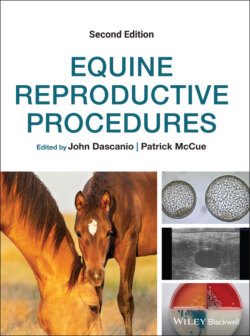Читать книгу Equine Reproductive Procedures - Группа авторов - Страница 36
Interpretation of qPCR Data
ОглавлениеThe number of threshold cycles (Ct cyles) required to replicate the original microbial DNA in the extracted sample (the template DNA) above the threshold level of detection (Figure 16.1) can be used to provide an approximation of the original DNA load. This can be used to provide an approximation of the number of microbial organisms in the original sample and the degree or severity of the infection (Table 16.1). Interpretation can be confounded by many factors including extraction efficiency, qPCR sensitivity, contamination during sample collection, handling, storage, and processing, type of microbial organism, mare health status, and other factors.
Table 16.1 Interpretation of qPCR results relative to degree of infection in equine uterine samples based on studies performed at Colorado State University.
| Number of Ct Cycles | Degree of Infection | Comments |
|---|---|---|
| ≥35 | None evident | Negative sample. If microbial DNA is detected, it is most likely due to contamination. Results need to be compared to negative controls |
| 30–34 | Mild | Low amount of bacterial DNA. Interpretation should include results of other diagnostic tests |
| 20–30 | Moderate | Presence of microbial DNA at a level consistent with infection |
| <20 | Severe | A large amount of microbial DNA detected |
The lower limit of detection of the bacterial organism Streptococcus equi subspecies zooepidemicus in equine uterine fluid has been reported to be 429 × 10–12 g, which is approximately 40 organisms worth of DNA. The lower limit of detection of DNA for the fungal organism Candida albicans has been reported to be 2 × 10–14 g. Since C. albicans contains approximately 37 fg of DNA, the qPCR assay theoretically has a detection limit of two yeast organisms.
